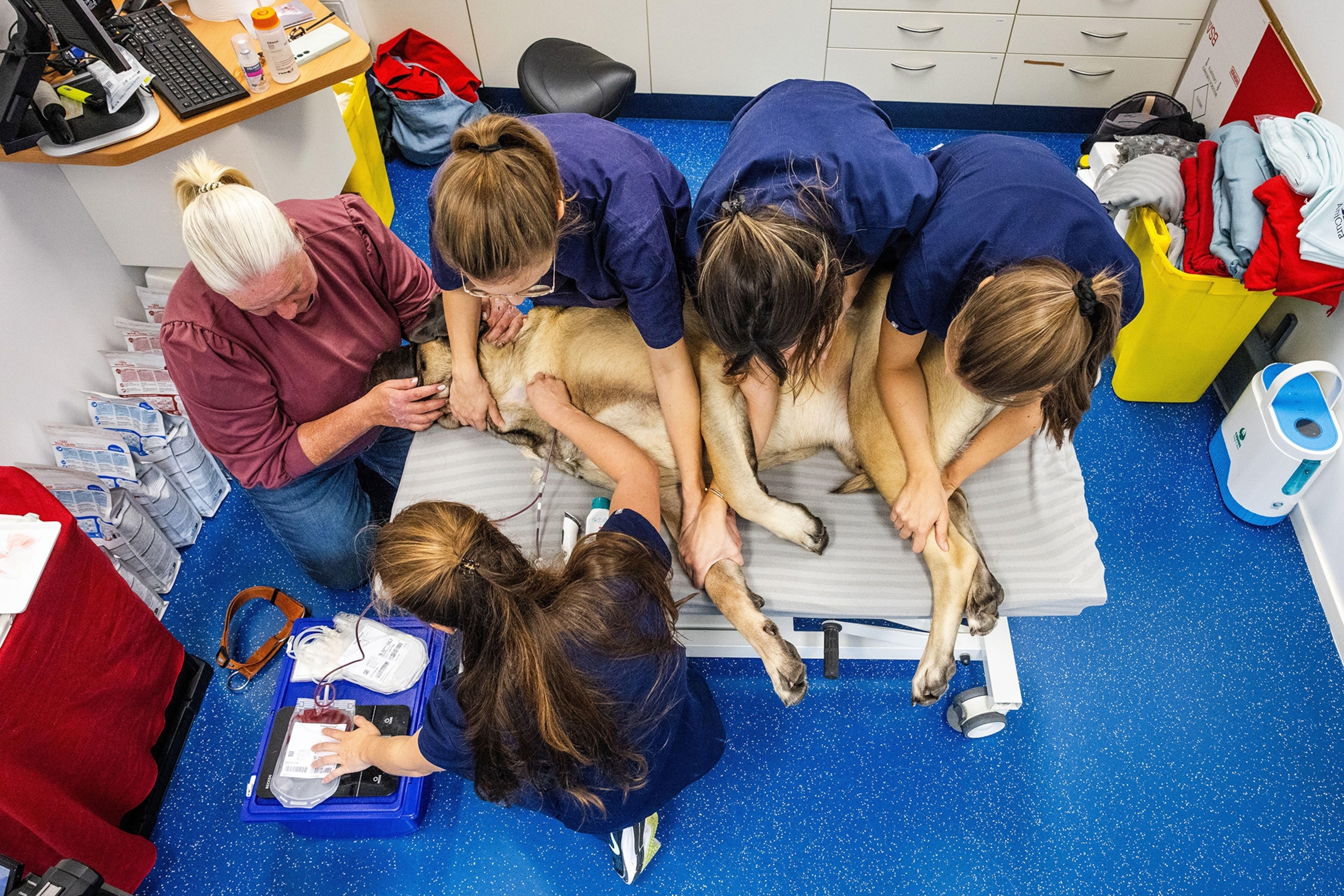Inside the life-saving world of canine blood donors
Whether it’s emergency trauma or chronic illnesses, pets often need blood transfusions. The U.K. is pioneering a national blood bank system that has already saved countless lives.

By the time the two puppies arrived, their situation was already dire. After eating rat bait, the 16-week-old boxers were ghostly pale—"white gums, lethargic, barely able to lift their heads,” recalls Karyn Kanowski, then a veterinarian at the only animal hospital in Alice Springs, a remote city in Australia’s Northern Territory. “I didn’t hold out much hope.”
The poison had robbed the dogs of their ability to clot blood, leaving them hemorrhaging internally. Without an immediate transfusion on that evening in 2011, they wouldn’t have lasted the night.
Desperate, Kanowski called on an unlikely hero: Bruce, a large mastiff belonging to one of the clinic’s receptionists. Bruce had donated blood before and was known for his calm demeanor. (Learn why dogs are more like us than we thought.)
“He was a legend,” she says. “Nothing fazed him. We drew about 400 milliliters and split it between the two pups.”
With Bruce’s donation and the clinic’s remaining plasma stores, the puppies were stabilized. Slowly, their gums regained color. Five days later, they went home, wagging their tails as if nothing had happened.
For Kanowski, who now works in Newquay, England, it was a baptism by fire into the world of canine blood transfusions. In 2011, a rapid increase in the mice population in Australia had created a spike in rat bait poisoning, inundating several vet clinics with sick patients.
“That summer taught me just how critical blood donations are,” she says, adding each pint of blood can save up to four lives.
Once considered rare and ad hoc, transfusions have become a life-saving tool in modern veterinary medicine. The demand for blood products in pets has skyrocketed in recent years, particularly in the United Kingdom, which is leading the way in canine blood donors.
The U.K.’s most prolific canine donor, Sharwood, a Gordon setter, recently retired after his 40th donation at age 7, having helped save the lives of up to 160 other dogs.
A shift toward dog blood banking
About two decades ago, the U.K. passed the Veterinary Medicines Regulations of 2005 so that dog blood could be collected, processed, and stored systematically, creating a reliable national supply—much like the country’s human blood banking system. (Read about the inventor of the mobile blood bank.)
Advances in veterinary care have driven much of the demand for blood banking. “Treatments are getting more sophisticated,” explains Lara Howe, veterinary surgeon and clinical supervisor at Pet Blood Bank U.K., a nonprofit founded in 2007 that has 14,000 registered donors and collects more than 3,000 units of blood annually.
“We’re seeing more options for pets than ever before—procedures and therapies that simply weren’t available even 20 years ago.”
At the same time, “dogs are more likely to need transfusions now than they were even a decade ago,” she says.
And the need goes beyond emergencies. Immune-mediated diseases, where a dog’s body attacks its own blood cells, are one of the most common causes for transfusions. In these cases, a transfusion buys crucial time, keeping the dog alive until medication can take effect and the body begins fighting the disease on its own.
As the field continues to grow, so does the need for awareness.
“Most people don’t think about blood donation for pets until they’re faced with a crisis,” says Howe. “But when you see what a single donation can do, it’s clear how important this is.”
The science of saving lives
Dogs have two blood types: DEA 1 positive and DEA 1 negative. For vets, DEA 1 negative dogs are the gold standard—universal donors, capable of helping any recipient in a crisis.
To qualify as a donor in the U.K., dogs must meet a strict set of criteria: Being fit, healthy, and between one and eight years of age, as well as weighing over about 55 pounds and having a good temperament.
Many owners are motivated by a desire to help other pets in need, much like human blood donors, says Howe.
“A nervous dog isn’t a good candidate,” she points out. “We need dogs who enjoy meeting new people and are comfortable at the vet.” Potential donors also undergo a health screening to rule out diseases or any medications in their system.
Once approved, the dogs come to the clinic, where a veterinary nurse numbs the area with local aesthetic, and the blood is drawn in a matter of minutes. Afterward, the dog gets a treat. In the U.S., owners who volunteer their dogs sometimes get free treatment or food vouchers from the clinic. (Read about the healing power of dogs.)
Blood is drawn into standard human bags, then separated into components—red blood cells, plasma, and platelets. “Platelets are crucial for clotting factors but expire in just five days,” Howe explains. “Plasma, though, can be frozen for years, giving us a reliable resource.”
For dogs that donate regularly, the process becomes routine. “Some of them love it,” Howe says. “They get treats, attention, and the satisfaction—well, maybe we do—of saving lives.”
As demand for blood products increases, there’s also the possibility of expanding the service to cats. While not yet fully operational, the Pet Blood Bank U.K. is already accepting registrations for healthy, large cats who enjoy being handled and spending time with people.
‘Quiet heroes’
Meanwhile, in the U.S. and other developed countries, canine blood donor systems are more fragmented, relying heavily on donations from staff pets and client animals. A limited number of larger practices in the U.S. maintain their own blood supplies or have agreements with nearby clinics.
“It’s a constant challenge,” says David McGuffin, medical director at Riverside Drive Animal Care Center in Dublin, Ohio, which supports the Greyhound Health Initiative Canine Blood Bank, also in Dublin. With 94 donors, the initiative has collected and distributed over 5,100 units of blood. “We’re always educating pet owners and trying to expand our donor base, but it’s an uphill battle.”
To owners skeptical about the process, McGuffin emphasizes that donor dogs are treated with the utmost care and respect. "If a dog is uncomfortable at any point, we stop," he says.
Adds Howe, of Pet Blood Bank U.K.: “These donor dogs are the quiet heroes of veterinary care. Their impact can’t be overstated.”






